High-Performance Building Enclosure Design for a Net-Zero Ready Habitat for Sub-Zero Wildlife
The Challenge of Multiple User Environments
The most difficult challenge of the PPCC project was designing for two very different climates/environments within a single building. Not only was there the unique penguin habitat, but staff and visitors had to be kept comfortable. In Figure 1 you can see how the two user groups, penguins and people, share this facility. The human habitat wraps around the penguin habitat … one climate surrounding the other. This drove the design of the vapor barrier and insulation in order to keep one space cool and the other warm. A natural feeling habitat for the penguins was imperative. In fact, the Zoo directed the project team to, when in doubt, always design to benefit the animal’s welfare.
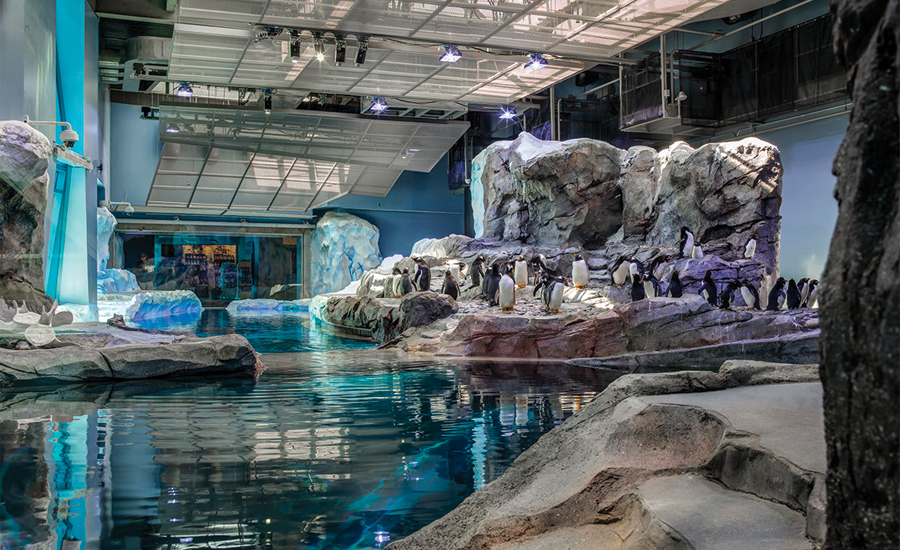
Photo courtesy of Maconochie Photography
Uniquely designed skylights in the penguin habitat allowed in UV light rays needed by the birds to maintain their natural biorhythms and limited the formation of infrared rays.
This included daylighting and temperature. There are skylights in the penguin habitat, but they are a special type that allows UV light to penetrate into the pool area. Penguins require UV light to maintain their natural biorhythms. This was an energy conservation challenge because once UV rays enter the space they can lengthen to create infrared rays—which will produce heat. The skylights were designed to limit infrared rays using long solar tubes and adding a scrim help disperse the UV rays. This limits the amount of possible infrared rays.
However, allowing in the UV rays means the space has a higher than normal solar heat gain coefficient. This could increase the mechanical cooling unit loads and increase energy use by the mechanical systems to cool the penguin habitat space, but since penguins are flightless birds, the space only needed to maintain proper temperatures up to 7 feet above the floor. Because only the first 7 feet above ground and pool level has be at 37 F, the temperature of the air space within the penguin habitat is stratified. This facility is very cooling intensive. In order to be energy-efficient the design had to limit the need to cool, and the interior walls are part of the solution.
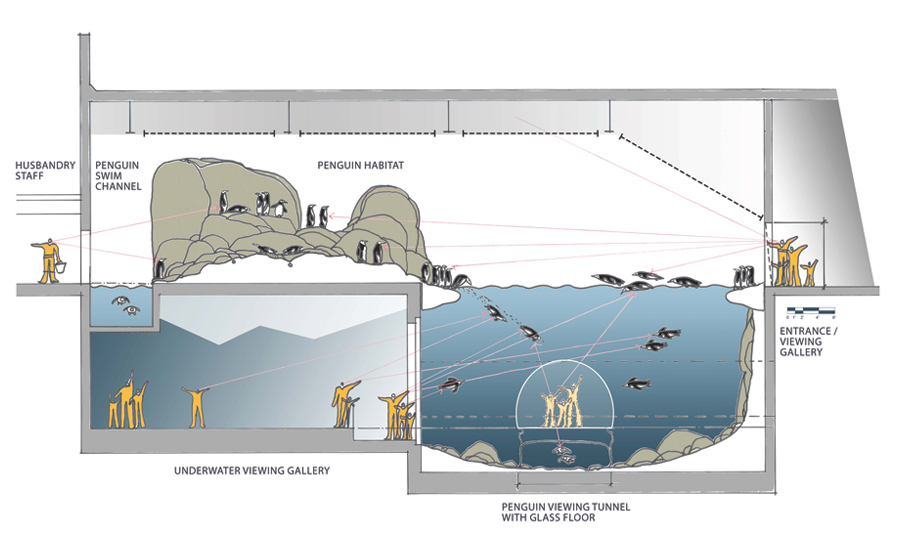
Illustration courtesy of Albert Kahn Associates Inc.
Figure 1: Habitat section diagram. You can see how the two user groups, penguins and people, share this facility. The human habitat wraps around the penguin habitat—one climate surrounding another climate.
The interior walls are designed to maintain two distinct climates/temperatures. Staff and visitors experience 68 to 72 F, depending on the time of year. The penguin habitat stays at 37 F all year, including the water in the deep pool. There are animal husbandry rooms within the staff/maintenance area that can be set at a wide range of temperatures—from 37 to 72 F. These rooms are used for incubating the penguin eggs (warm) and gradually acclimating the young birds to the colder temperature of the main penguin habitat (warm to cool).
Insulated walls separate all the different environments within the building. The penguin habitat is separated from the rest of the building using a CMU cavity wall. It is set with 2.5 inches of foam-in-place insulation, including above and below the wall cavity. This provides the same R-value between the penguin habitat and the visitor’s spaces below the pool (Figure 2).
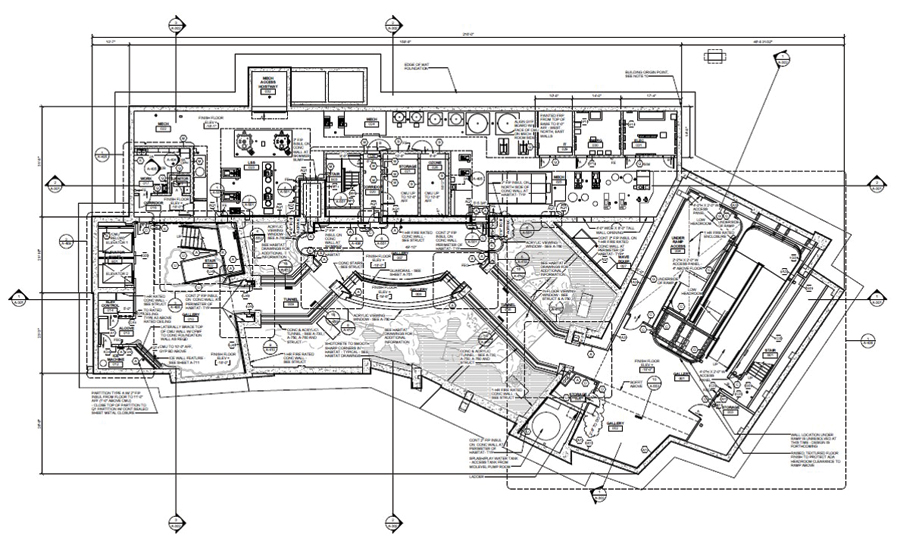
Illustration courtesy of Albert Kahn Associates Inc.
Figure 2: All around the pool we have a separation, with exception of the visitor’s tunnel/tube which is acrylic. Where it is a wall, it is a cavity wall to prevent thermal transmission and keep the water temperature cold.
The interior glazing is acrylic because of its higher thermal performance compared to glass. Some acrylic panels are as thick as 9 inches. Acrylic was used for both the pool and above ground viewing areas to limit the heat transfer between the two environments.
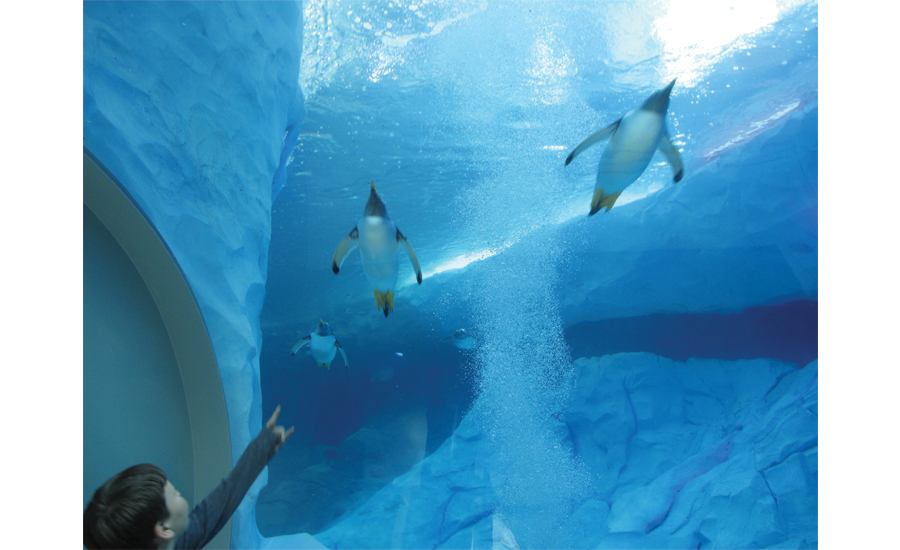
Photo courtesy of Maconochie Photography
Acrylic glazing was used to separate the users' habitats in the viewing tunnels on the lower level because of its higher thermal performance compared to glass. The panels varied in width, some 9 inches thick.
The pool floor and walls are insulated for a broad range of conditions. In some locations, the insulation is between the pool and interior conditioned spaces, and in others it’s between the pool and an exterior wall. The insulation and vapor barrier relationship is also unique depending on location; the vapor barrier placement varies in each temperature zone, but is typically placed on the warmer side. Because the penguin habitat is always cold and the dew point varies with the weather/seasons, the vapor barrier in this location is at the midpoint of the insulation.
The Building Enclosure
A building’s exterior is similar to skin on the human body. It protects all of the building’s internal systems from the outside world. The building “skin” includes both the vertical (wall, windows and doors) and horizontal (roof and slab) systems encasing the building. The building enclosure system plays an important role in how much energy a building uses.
Thousands of custom metal scales cover the exterior skin of the PPCC. The layered-envelope system functions similarly to the penguin’s coat of feathers. Based on their anatomical coat, biomimicry inspired the design. The final design solution was based on benefits to the penguin habitat and cost value, which included energy savings and the actual cost.
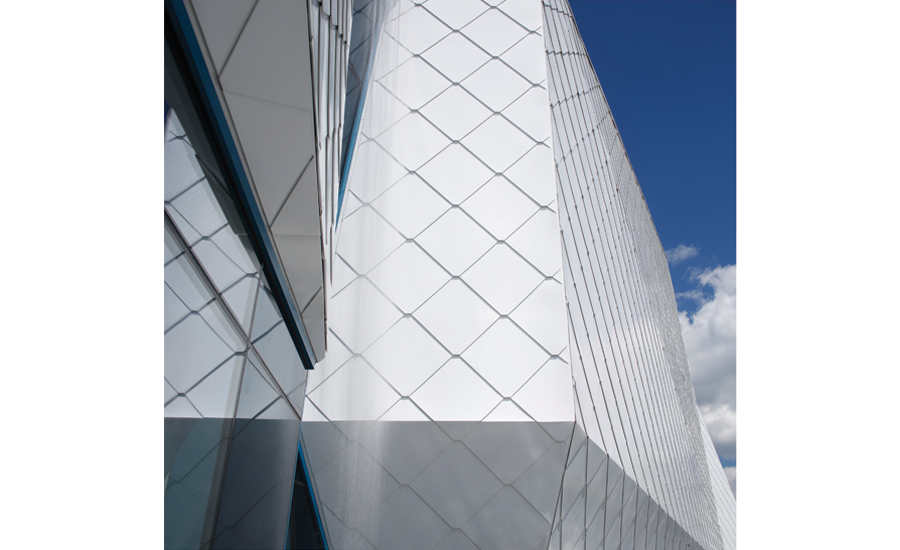
Photo courtesy of Maconochie Photography
Thousands of custom, insulated metal scales cover the exterior of the Polk Penguin Conservation Center. They are an integral part of the layered, energy-efficient building enclosure system.
First, for the PPCC and any high-performance building, it’s very important to evaluate all the different types of building envelopes and how they impact energy performance. In this case, insulated metal panels, a rainscreen option, CMU, brick facades and many others were evaluated. An insulated metal panel back-up wall and a CMU back-up wall were evaluated. Energy calculations were performed on all options. After completing the evaluation, it was determined that the best choice was a system using the insulated metal panels with a rainscreen back-up wall. The design used sheathing and metal studs to support the insulation. Next, the type and depth of the insulation and its location were evaluated. For example, the team asked questions like, “Where should the insulation panel be located?” “If we included foam-in-place, where would it be located?” and “Do we use mineral fiber or some other insulation and where is it located?” After this series of analyses, the vapor barriers and their location were evaluated—again continually looking at the impact of each design scenario on energy usage and achieving penguin habitat criteria. During the entire design process, the goal was to create a vapor and airtight envelope.
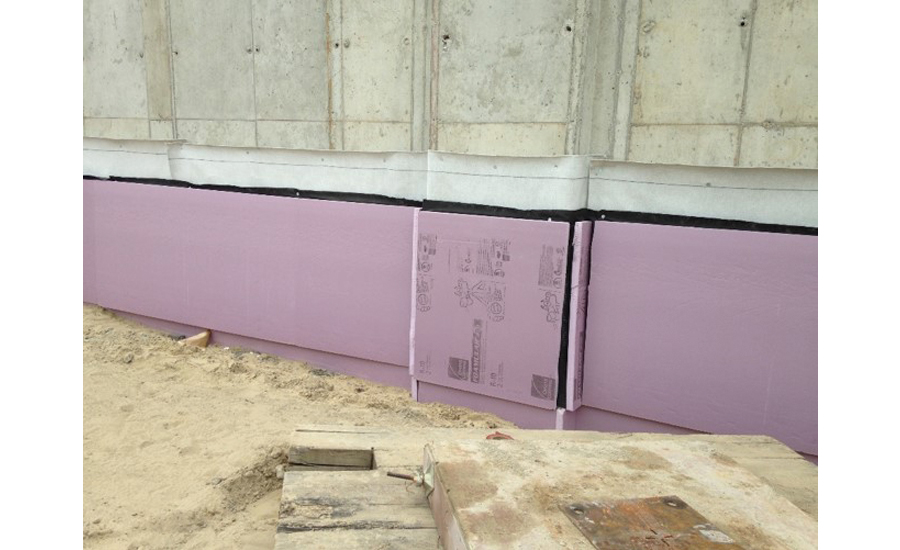
Photo courtesy of Albert Kahn Associates Inc.
The entire foundation was encapsulated with a vapor barrier, water proofing, and insulation to protect against thermal transmission.
This was accomplished using sheet membranes and sealants. The insulated metal panels work as both a vapor and an air barrier in a rainscreen application. Selected as the best solution, it met the high-performance goal of longevity and durability. With two distinct temperature environments, this system best controlled vapor. Dew point calculations were run and showed that in both environments … cold in the penguin habitat and hot or cold on the outside … warm in the visitor/staff areas and hot or cold on the outside—the dew point was never in the danger position. This design helps avoid maintenance issues within the building.
To protect against thermal transmission, the entire foundation was encapsulated with a vapor barrier, water proofing and insulation. The 300,000-gallon penguin pool is 24 feet deep and because the water is kept at 37 F, it was imperative to protect it year-round from thermal transmission from the surrounding soil. In addition to the cavity wall around the foundation, shotcrete in conjunction with insulation was used at the perimeter to protect against thermal transmission.









